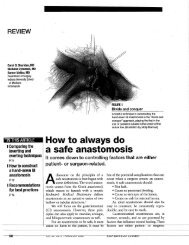SRPS PS - Plastic Surgery Internal
SRPS PS - Plastic Surgery Internal
SRPS PS - Plastic Surgery Internal
Create successful ePaper yourself
Turn your PDF publications into a flip-book with our unique Google optimized e-Paper software.
<strong>SR<strong>PS</strong></strong> Volume 10, Issue 25, 2009<br />
Malignant degeneration has not been reported.<br />
Epidermal Inclusion Cysts<br />
Epidermal inclusion cysts commonly occur on the<br />
palmar surface of the hand or digits of patients whose<br />
work or leisure activities predispose them to<br />
penetrating hand injuries. The time from the traumatic<br />
incident to cyst development varies from months to<br />
years. Clinically, the lesions are firm, spherical, and<br />
nontender. The cyst wall consists of squamous<br />
epithelium with laminated keratin, and the cyst material<br />
contains protein, cholesterol, fat, and fatty acids.<br />
Spontaneous rupture is common, but the lesion<br />
often persists unless the cyst lining, contents, and<br />
overlying puckered skin are surgically removed. Local<br />
complications include infections and bone erosion.<br />
Malignant Skin Tumors<br />
Malignant tumors of the skin of the hand make up a<br />
very small percentage of upper extremity neoplasms226- 228 and are primarily squamous cell carcinomas<br />
(SCC). 229–232 SCC predominate among people with fair<br />
skin and light hair color. The usual origin of SCC is<br />
ionizing solar radiation. Other less common causes of<br />
SCC are previous irradiation, 233 burn scars, exposure to<br />
arsenic compounds, and inherited genetic disorders. 234<br />
The dorsum of the hand, with the highest actinic<br />
exposure, is the most common site for SCC, although<br />
the tumor has been reported to also occur on the<br />
palms235 and subungually. 236–239 Appropriate treatment<br />
consists of a 4-mm margin for tumors with a diameter<br />
of less than 2 cm. When the size of the tumor exceeds<br />
those dimensions, a margin of 6 mm is necessary. 240 If<br />
evidence exists of nodal metastasis or local recurrence,<br />
axillary lymphadenectomy is recommended. The role<br />
of sentinel node biopsy in cases of SCC is not yet<br />
defined in the literature. SCC of the hand is an<br />
aggressive tumor prone to recurrence and metastasis.<br />
The metastatic rate for SCC of the hand is higher than<br />
elsewhere on the body, particularly if the primary<br />
lesion involves the digital web space. 230<br />
Basil cell carcinomas—Basal cell carcinomas (BCC)<br />
are very uncommon tumors on the finger. 241 Palmar<br />
variants have been observed, 242 especially in cases of<br />
Gorlin’s syndrome (multiple nevoid BCC syndrome), 243<br />
and BCC has been reported to also occur<br />
16<br />
subungually, 244 in which case differentiation from a<br />
subungual melanoma must be made. 245 Although BCC<br />
do not metastasize, they are locally aggressive.<br />
Excision is the usual form of treatment.<br />
Melanomas—Melanomas of the hand can occur on<br />
the palm 246–255 or subungually. 256–259 A study by Ridgeway<br />
et al. 255 showed that the acral histological subtype does<br />
not affect the disease-free and overall survival. Tumor<br />
thickness remains the only prognostic indicator.<br />
Slingluff et al. 252 found that acral melanoma has a<br />
strong racial predilection, carries a grave prognosis,<br />
and arises from glabrous skin. In that study, no<br />
survival difference was shown between volar and<br />
subungual sites, nor did amputation make a difference.<br />
Melanoma requires wide excision or amputation of the<br />
digit or hand, depending on location and depth. 260–262<br />
The appropriate level of amputation has not been<br />
determined. Papachristou and Fortner 256 advocated<br />
amputation through the carpometacarpal joint,<br />
whereas Finley et al. 258 performed seven finger<br />
amputations distal to the metacarpophalangeal joint<br />
(four just proximal to the distal interphalangeal joint<br />
and three just proximal to the proximal interphalangeal<br />
joint), with no local recurrences. Quinn et al. 259 showed<br />
no difference in local recurrence for subungual<br />
melanomas whether amputations are performed<br />
proximal or distal to the interphalangeal joint of the<br />
thumb or the middle of the middle phalanx in the<br />
fingers. Similarly, no prospective study to date has<br />
shown a survival or local control benefit to prophylactic<br />
lymph node dissection, regional perfusion, or<br />
immunotherapy. 263–265 The use of sentinel lymph node<br />
biopsy has grown significantly in recent years. 266,267<br />
Bony Tumors<br />
Several authors have presented excellent reviews of<br />
bony tumors of the hand. 268–270 Treatment is based on<br />
accurate diagnosis and staging of the lesions (Table 3).<br />
Chondromas<br />
Chondromas are the most common benign<br />
cartilaginous tumors of the hand. 271,272 Chondromas that<br />
remain within the substance of the bone or cartilage<br />
are called enchondromas. 273–275 Enchondromas favor the<br />
tubular bones of the hand, especially the middle and<br />
proximal phalanges. Congenital cartilaginous rests are






